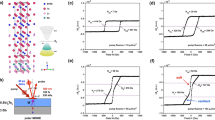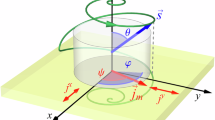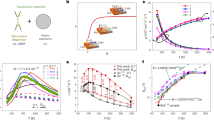Abstract
Topological insulators are a class of solids in which the non-trivial inverted bulk band structure gives rise to metallic surface states1,2,3,4,5,6 that are robust against impurity scattering2,3,7,8,9. In three-dimensional (3D) topological insulators, however, the surface Dirac fermions intermix with the conducting bulk, thereby complicating access to the low-energy (Dirac point) charge transport or magnetic response. Here we use differential magnetometry to probe spin rotation in the 3D topological material family (Bi2Se3, Bi2Te3 and Sb2Te3). We report a paramagnetic singularity in the magnetic susceptibility at low magnetic fields that persists up to room temperature, and which we demonstrate to arise from the surfaces of the samples. The singularity is universal to the entire family, largely independent of the bulk carrier density, and consistent with the existence of electronic states near the spin-degenerate Dirac point of the 2D helical metal. The exceptional thermal stability of the signal points to an intrinsic surface cooling process, probably of thermoelectric origin10,11, and establishes a sustainable platform for the singular field-tunable Dirac spin response.
This is a preview of subscription content, access via your institution
Access options
Subscribe to this journal
Receive 12 print issues and online access
$259.00 per year
only $21.58 per issue
Buy this article
- Purchase on SpringerLink
- Instant access to full article PDF
Prices may be subject to local taxes which are calculated during checkout




Similar content being viewed by others
Change history
22 May 2014
In the version of this Letter originally published, in Fig. 3a, the values of n should have read '~1019 cm–3' and '~1017 cm–3'. This error has now been corrected in the online versions of the Letter.
References
Fu, L., Kane, C. L. & Mele, E. J. Topological insulators in three dimensions. Phys. Rev. Lett. 98, 106803 (2007).
Hasan, M. Z. & Kane, C. L. Topological insulators. Rev. Mod. Phys. 82, 3045–3067 (2010).
Qi, X-L. & Zhang, S-C. Topological insulators and superconductors. Rev. Mod. Phys. 83, 1057–1110 (2011).
Chen, Y. L. et al. Experimental realization of a three dimensional topological insulator Bi2Te3 . Science 325, 178–181 (2009).
Hsieh, D. et al. Observation of time-reversal-protected single-Dirac-cone topological-insulator states in Bi2Te3, and Sb2Te3 . Phys. Rev. Lett. 103, 146401 (2009).
Zhang, H. et al. Topological insulators in Bi2Se3, Bi2Te3, and Sb2Te3 with a single Dirac cone on the surface. Nature Phys. 5, 438–442 (2009).
Hsieh, D. et al. Observation of unconventional quantum spin textures in topological insulators. Science 323, 919–922 (2009).
Roushan, P. et al. Topological surface states protected from backscattering by chiral spin texture. Nature 460, 1106–1109 (2009).
Yazyev, O. V., Moore, J. E. & Louie, S. G. Spin polarization and transport of surface states in the topological insulators Bi2Se3 and Bi2Te3 from first principles. Phys. Rev. Lett. 105, 266806 (2010).
Venkatasubramanian, R., Siivola, E., Colpitts, T. & O’Quinn, B. Thin-film thermoelectric devices with high room-temperature figures of merit. Nature 413, 597–602 (2001).
Wang, Y. H. et al. Measurement of intrinsic Dirac fermion cooling on the surface of the topological insulator Bi2Se3 using time-resolved and angle-resolved photoemission spectroscopy. Phys. Rev. Lett. 109, 127401 (2012).
Hsieh, D. et al. A tunable topological insulator in the spin helical Dirac transport regime. Nature 460, 1101–1105 (2009).
Essin, A. M., Moore, J. E. & Vanderbilt, D. Magnetoelectric polarizability and axion electrodynamics in crystalline insulators. Phys. Rev. Lett. 102, 146805 (2009).
Fu, L. & Kane, C. L. Superconducting proximity effect and Majorana fermions at the surface of a topological insulator. Phys. Rev. Lett. 100, 096407 (2008).
He, X. et al. Surface termination of cleaved Bi2Se3 investigated by low energy ion scattering. Phys. Rev. Lett. 110, 156101 (2013).
Bahramy, M. S. et al. Emergent quantum confinement at topological insulator surfaces. Nature Commun. 3, 1159 (2012).
Mansfield, R. The magnetic susceptibility of bismuth telluride. Proc. Phys. Soc. 74, 599–603 (1959).
Zhang, F., Kane, C. L. & Mele, E. J. Surface states of topological insulators. Phys. Rev. B 86, 081303(R) (2012).
Bychkov, Y. A. & Rashba, E. I. Oscillatory effects and the magnetic susceptibility of carriers in inversion layers. J. Phys. Chem. 17, 6039–6045 (1984).
Fu, L. Hexagonal warping effects in the surface states of the topological insulator Bi2Te3 . Phys. Rev. Lett. 103, 266801 (2009).
Wołoś, A. et al. Landau-level spectroscopy of relativistic fermions with low Fermi velocity in the Bi2Te3 three-dimensional topological insulator. Phys. Rev. Lett. 109, 247604 (2012).
Analytis, J. G. et al. Two-dimensional Dirac fermions in a topological insulator: Transport in the quantum limit. Nature Phys. 6, 960964 (2010).
Vazifeh, M. M. & Franz, M. Spin response of electrons on the surface of a topological insulator. Phys. Rev. B 86, 045451 (2012).
Martin, J. et al. Observation of electron–hole puddles in graphene using a scanning single-electron transistor. Nature Phys. 4, 144–148 (2008).
Beidenkopf, H. et al. Spatial fluctuations of helical Dirac fermions on the surface of topological insulators. Nature Phys. 7, 939–943 (2010).
Crepaldi, A. et al. Evidence of reduced surface electron–phonon scattering in the conduction band of Bi2Se3 by non-equilibrium ARPES. Phys. Rev. B 88, 121404(R) (2013).
Li, Y-X. Thermopower in quasi-one-dimensional nano-constrictions with spin–orbit interaction. Phys. Lett. A 358, 7073 (2006).
Ren, J., Fransson, J. & Zhu, J-X. Nanoscale thermal spin rectifier: Controlling spin Seebeck transport across charge insulating magnetic junctions with localized spin. Preprint at http://www.arxiv.org/cond-mat/1310.4222v1 (2013)
Sellitto, A., Alvarez, F. X. & Jou, D. Phonon-wall interactions and frequency-dependent thermal conductivity in nanowires. J. Appl. Phys. 109, 064317 (2011).
Snyder, G. J., Toberer, E. S., Khanna, R. & Seifert, W. Improved thermoelectric cooling based on the Thomson effect. Phys. Rev. B 86, 045202 (2012).
Acknowledgements
We greatly appreciate the insights of K. Park and thank G. Refael for his useful suggestions and comments. We gratefully acknowledge G. Kowach for his generous help and expert advice with the Bridgman crystal growth and A. Wołoś for selecting crystals with low carrier density. This work was supported by the NSF DMR-1122594 and DOD-W911NF-13-1-0159 (L.K-E.), and DMR-0955714 (V.O.).
Author information
Authors and Affiliations
Contributions
Experiments were designed by L.Z. and L.K-E. L.Z. and H.D. carried out the growth of single crystals, M.K. and A.H. provided Bi2Te3 crystals with the lowest carrier densities, and I.K. and Z.C. performed structural and chemical characterization of all crystals. The a.c. susceptibility measurements were done by L.Z. and H.D., and data analysis was done by L.Z. and L.K-E. Dirac phenomenology and the mechanism of Peltier cooling were formulated jointly by V.O. and L.K-E. L.K-E. and V.O. wrote the manuscript with critical input from L.Z.
Corresponding author
Ethics declarations
Competing interests
The authors declare no competing financial interests.
Supplementary information
Supplementary Information
Supplementary Information (PDF 1858 kb)
Rights and permissions
About this article
Cite this article
Zhao, L., Deng, H., Korzhovska, I. et al. Singular robust room-temperature spin response from topological Dirac fermions. Nature Mater 13, 580–585 (2014). https://doi.org/10.1038/nmat3962
Received:
Accepted:
Published:
Issue date:
DOI: https://doi.org/10.1038/nmat3962
This article is cited by
-
The Singularity Paramagnetic Peak of Bi0.3Sb1.7Te3 with p-type Surface State
Nanoscale Research Letters (2022)
-
On the Paramagnetic-Like Susceptibility Peaks at Zero Magnetic Field in \(\hbox{WSe}_{2-x}\hbox{Te}_{x}\) Single Crystals
Nanoscale Research Letters (2022)
-
Exploration of the role of disorder and the behaviour of the surface state in the three-dimensional topological insulator—Bi2Se3
Bulletin of Materials Science (2022)
-
The Magnetic Susceptibility Bifurcation in the Ni-Doped Sb2Te3 Topological Insulator with Antiferromagnetic Order Accompanied by Weak Ferromagnetic Alignment
Nanoscale Research Letters (2021)
-
Emergent topological fields and relativistic phonons within the thermoelectricity in topological insulators
Scientific Reports (2021)



